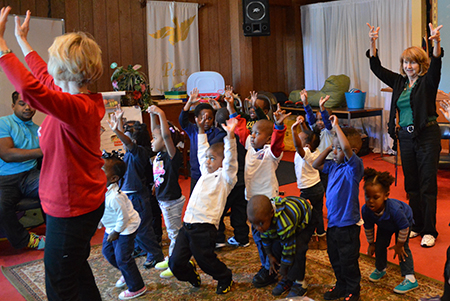When you observe curious, giggling, fidgeting four year-olds, it’s hard to imagine them as future businessmen and women. But these young minds are absorbing everything around them at a rapid rate and statistics show early education is the key to future academic success. (The young brain forms more than 700 neural connections every second!). However, only 54% of Hispanic and African American students in South Carolina graduate from high school, and more rural “dropout factories” exist here than in any other state in the country. Research shows that the opportunity gap between low and high income students begins before kindergarten and widens over time. This makes early educators a critical first line of defense against educational inequity.

The Gibbes Museum of Art has partnered with Charleston County First Steps to introduce preschool children to the fundamentals of art in a hands-on way. Rebecca Sailor, Curator of Education, and a team of teaching artists and museum educators have joined with First Steps Child Development Centers to offer experiences with colors, shapes, lines, textures, portraits, landscapes and pictures that tell a story.
“Gibbes educators and teaching artists are assisting the child care centers teachers on how to use the visual arts to expand their classroom curriculum. They demonstrate using literature, music and theater as well as hands-on art to encourage deeper learning of shape, line and color. The children are now recognizing these concepts in the world around them. Because the Gibbes educators and teaching artists are working with teachers and children on a continuous basis, they are forming relationships and are eager to learn more,” says Mrs. Sailor.
Lorraine Powers, chair of the Charleston County First Steps board and former Gibbes board member sparked the initial idea to encourage more African-American families to engage with the Gibbes museum through Eye Spy, an in-school program originally designed to help Charleston County School District elementary students look at and talk about art. Gibbes’ museum educators work with classroom visual arts teachers throughout the school year, creating interactive lesson plans. Classroom visits, using objects from the Gibbes’ collection, and major artists highlight the elements of art, introduce broad explanations of style, and teach students to compare and contrast.
Mrs. Powers says, “I think it’s really important to expose all young children between the ages of three and five to a variety of experiences. Young children are like sponges and absorb everything. Who knows, there may be a Jonathan Green, Romare Bearden or David C. Driskell amongst them, but first they have to know/see what is possible.”

In 2013 the pilot project was supported by the Continental Society, an international public service organization dedicated to the socioeconomic and cultural welfare of underprivileged children and youth, and Charleston County First Steps, who joined forces to provide funding for this endeavor. Charleston County First Steps helps to prepare young children to reach school healthy and ready to learn. The Eye Spy First Steps program is now offered in seven child development centers including Carousel, Child & Family, First African, Van Buren, New Israel, NIA, and Foster’s led by Gibbes Museum educators and teaching artists.
“The Eye Spy program works with children who are not often exposed to visual art concepts and cultural art pieces. The program expands their world by introducing them to the artworks from the Gibbes Museum, as well as to art concepts in general. It’s been inspiring for me to see the children gain an appreciation for art and the joy it brings them. The children also discover that there is a wonderful art museum in their own city that they never knew about and now can’t wait to visit when the museum reopens! The Eye Spy program is designed in a really fun, engaging way that makes them really want to be part of the world of art,” says teaching artist Leonora Dechtiar.
We look forward to continuing this program and incorporating field trips to the museum when the Gibbes reopens in spring of 2016. Engaging the students with actual works of art allows for a richer experience for these young students. Paintings that have been discussed in the centers will be seen in their actual, full enormity, and richness of color.
—Amy Mercer, Marketing and Communications Manager
Published April 2, 2015

